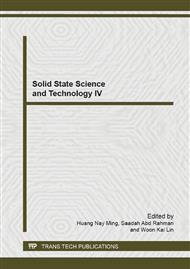p.99
p.105
p.111
p.116
p.125
p.130
p.134
p.138
p.142
Photoalignment Studies on Azo Containing Thiophene Based Acrylates
Abstract:
The photoalignment properties of thin films made from several azo-containing thiophene-based acrylate with respect to the commercially available nematic liquid crystal (MLC 6873-100; ε>o) is reported. As observed, the photoalignment ability of these films is influenced by the number and disposition of fluoro-substituents and the position of attachment of the terminal thiophene moiety. Inclusion of a lateral fluoro-substituent (s) provides excellent photo alignment ability whereas the non-fluorinated counterpart tends to give unsatisfactory alignment quality. The performed study showed also that 2-substituted thiophenes give better photoalignment quality.
Info:
Periodical:
Pages:
125-129
Citation:
Online since:
February 2014
Keywords:
Price:
Сopyright:
© 2014 Trans Tech Publications Ltd. All Rights Reserved
Share:
Citation:


